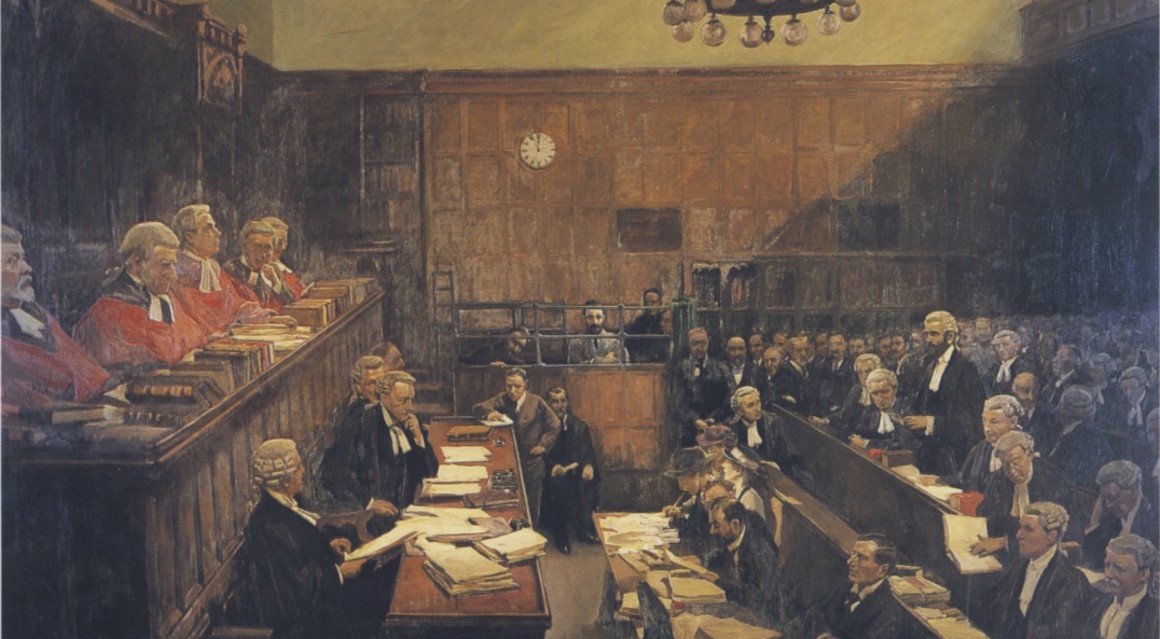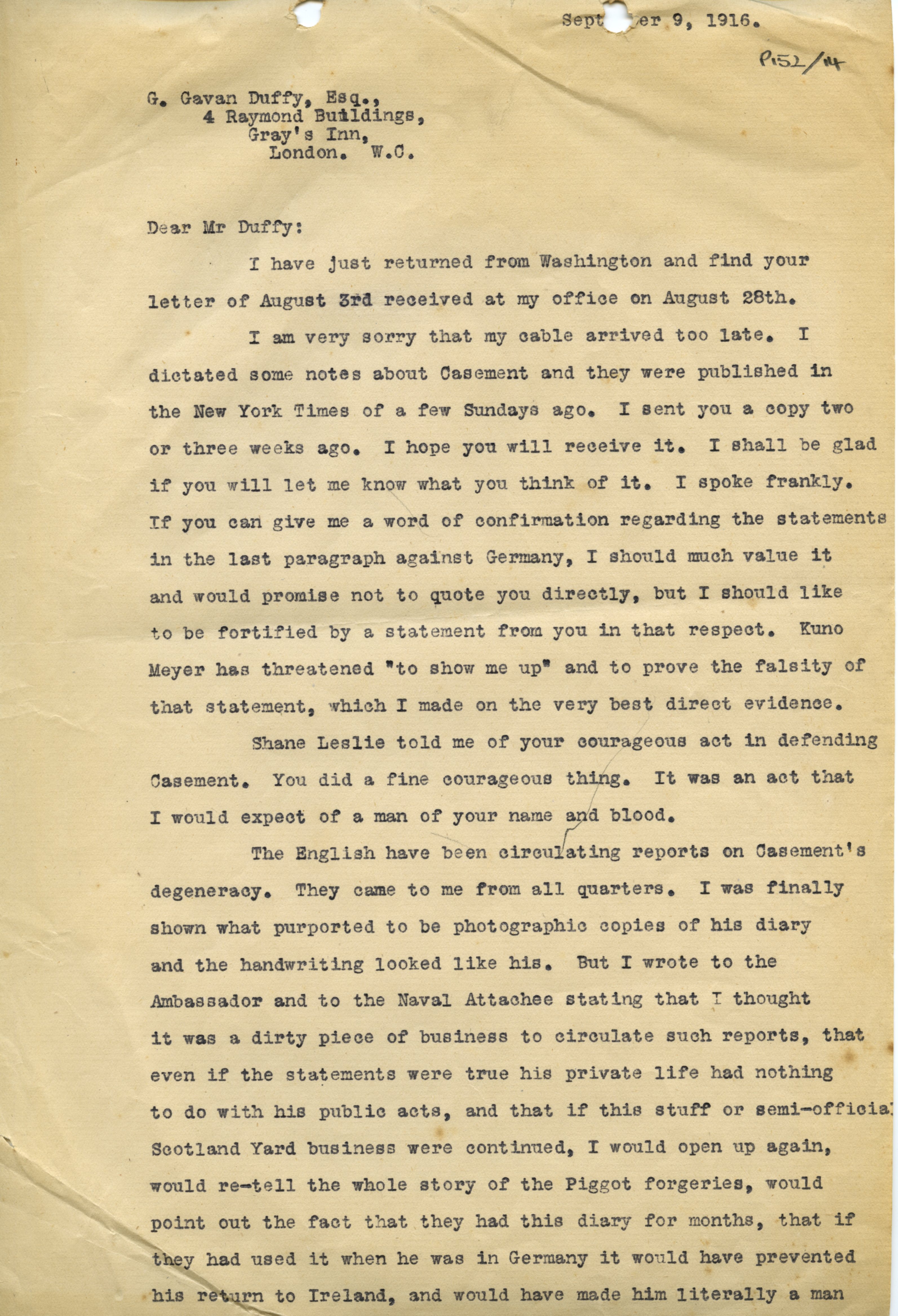FEATURED LETTER
Letter from John Quinn to George Gavan Duffy, 9 September 1916 (University College Dublin Archives)
by Edward Kearns
On 9 September 1916, John Quinn sent a letter across the Atlantic to his fellow lawyer George Gavan Duffy. A copy of this letter has found its way into the Letters of 1916 collection, and it serves as a fascinating portal to its time, and in particular to the context of Roger Casement’s execution.
Casement was hanged for treason on 3 August 1916. George Gavan Duffy had represented Casement at his trial, and Quinn commends Duffy for this in the letter, saying that it was “a fine and courageous thing.” In the space of two short pages, Quinn’s letter also references an article he had written for the New York Times about Casement ‘a few Sundays ago’, as well as several notable historical figures, and the infamous ‘Black Diaries’.

A search of the Times’ online archive leads to a lengthy tribute to Casement, written by Quinn, and published on Sunday, 13 August 1916. The article describes Casement as a martyr, and must surely have stirred the sympathies of its American readership. It is also reveals that Quinn knew Casement personally. Who was this American lawyer, and how had he come into contact with Casement?
John Quinn (1870-1924) was no ordinary lawyer. Based in New York, but with Irish roots, Quinn was highly successful from an early stage in his career. This gave him the freedom to pursue what seems to have been his true interest: contemporary literature and art, particularly work with origins on the other side of the Atlantic. He commissioned paintings by John Butler Yeats and Jack Yeats, and he supported literary figures such as J.M. Synge, W.B. Yeats, Lady Gregory and James Joyce (he defended Ulysses in court against obscenity charges in the U.S.). He corresponded with Joseph Conrad and Ezra Pound, and amassed an art collection featuring Seurat, Picasso, and Matisse amongst many others.
Casement had stayed in Quinn’s home in New York for ‘some weeks’ while fundraising for the Irish Volunteers in 1914. In the Times article Quinn states that Casement ‘had great personal charm and was a man of invariable kindness. Pretense of any kind was impossible to him’. When Casement was on trial two years later, Quinn did what he could to seek clemency for Casement, ultimately to no avail. A letter from Duffy to Quinn on 3 August acknowledges Quinn’s efforts. Perhaps realising the inevitable, Quinn had telegraphed Duffy to send his love to Casement; Duffy writes ‘unfortunately your cable arrived too late’.
In the September letter Quinn says that he ‘spoke frankly’ in his elegy for Casement, and in particular draws attention to the final paragraph of the article, in which he rails against Casement’s contacts in Germany, calling them ‘Judases’ for betraying Casement. He writes of this statement being challenged by Kuno Meyer, a controversial supporter of Germany who had been travelling the U.S. at the time of the First World War, but he stands by his argument. Indeed he goes on to wish defeat for Germany in the War, asking how ‘can any man with a drop of Irish blood in his veins ever again hope for the victory of these betrayers?’
Quinn also mentions John Randolph ‘Shane’ Leslie, a writer and lecturer who supported Home Rule and raised funds for the Gaelic League. Leslie also happened to be the cousin of a certain Winston Leonard Spencer Churchill.

The ending of Quinn’s letter takes aim at those responsible for ‘circulating reports on Casement’s degeneracy’; this refers to the aforementioned ‘Black Diaries’ allegedly written by Casement. Copies of the documents surfaced with suspicious convenience right at the time of Casement’s trial. Interestingly, Quinn admits that ‘the handwriting looked like [Casement’s]’. Eighty-six years later the Guardian would report that a forensic examination had indicated that ‘the handwriting, ink, paper, pen strokes and pencillings were all genuine’. Quinn concludes that ‘even if the statements were true his private life had nothing to do with his public acts’, and deems the release of the diaries when Casement was at his most vulnerable as a ‘dirty piece of business’, comparable to the case of the Piggott forgeries; faked letters from Charles Stewart Parnell that claimed he had supported the Phoenix Park murders of 1882. After Casement’s trial George Gavan Duffy would go on to campaign on Ireland’s behalf across Europe, and was one of the signatories of the Anglo-Irish Treaty, albeit reluctantly. His correspondent John Quinn would continue to patronise the modern culture of his ancestral home.
That is quite a story from one letter; it is funny how a century-old document can prove to be the launchpad for discovering so much historical context. And that context feeds back, enriching our understanding of the letter itself. Quinn knew everybody there was to know in that time and place. He was the perfect person to write an American elegy for Casement; the perfect bridge between the Old Bailey and New York City.
Edward Kearns studied English and Sociology in University College Dublin before moving on to the M.Phil course in Digital Humanities and Culture in Trinity College Dublin. He has written for the campus newspapers of both universities, and has recently completed his master’s thesis entitled ‘Data-Mining the Great American Novel’.
Bibliography:
George Gavan Duffy to John Quinn, 3 Aug. 1916 (New York Public Libraries, John Quinn Papers, [Call number]).
Ezard, John. “Sex Diaries of Roger Casement Found to Be Genuine.” The Guardian 13 Mar. 2002. Web. 19 June 2014.
Hogan, Gerard. “Duffy, George Gavan.” Dictionary of Irish Biography. Web. 19 June 2014.
Laffan, Michael. “Casement, Sir Roger David.” Dictionary of Irish Biography. Web. 19 June 2014.
Legg, Mary-Louise. “Pigott, Richard.” The Oxford Dictionary of National Biography. 23 Sept. 2004. Web. 19 June 2014.
Lysaght, Charles. “Leslie, John Randolph (’Shane’).” Dictionary of Irish Biography. Web. 19 June 2014.
Quinn, John. “Roger Casement, Martyr; Some Notes for a Chapter of History by a Friend Whose Guest He Was When the War Broke Out.” The New York Times 13 Aug. 1916: SM1. Print.
John Quinn to George Gavan Duffy, 9 Sep. 1916 (University College Dublin Archives) Letters of 1916. Web. 19 June 2014.
White, Lawrence William. “Quinn, John.” Dictionary of Irish Biography. Web. 19 June 2014.
Wingfield, Valerie. “John Quinn Memorial Collection 1900-1924: Finding Aid.” Nov. 1992. Web. 19 June 2014.